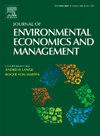饮用水中硝酸盐污染对出生结局的影响
IF 5.9
3区 经济学
Q1 BUSINESS
Journal of Environmental Economics and Management
Pub Date : 2025-06-06
DOI:10.1016/j.jeem.2025.103197
引用次数: 0
摘要
尽管饮用水污染在美国很普遍,但其对健康的影响还没有得到很好的了解。与对空气污染对健康影响的广泛研究不同,对水污染的研究是有限的,主要是由于缺乏高频水污染数据。为了解决这一差距,我构建了一个新的数据集,将加州社区供水系统中每月硝酸盐污染水平与个人出生记录联系起来。硝酸盐污染是美国水系统中一个长期存在的问题,对婴儿健康构成潜在威胁。本研究估计产前暴露于硝酸盐污染的影响低于目前的监管限制对分娩结果。使用水系统和时间固定效应的面板固定效应方法,我比较了来自同一水系统的婴儿的出生结果,他们在妊娠的每个三个月暴露于不同水平的硝酸盐污染。我发现妊娠中期暴露于低于规定限制的硝酸盐浓度会使早产和低出生体重的可能性分别增加1.2和1个百分点。相对于样本平均值,这些估计转化为早产的概率增加15% %,低出生体重出生的概率增加17% %。结果进一步表明,将目前的监管限值降低到5 mg/L以下(目前限值的一半)可以预防硝酸盐相关的不良出生结局。本文章由计算机程序翻译,如有差异,请以英文原文为准。
Birth outcome effects of nitrate contamination in drinking water
Despite the prevalence of drinking water contamination in the United States, its health effects are not well understood. Unlike the extensive research on health impacts of air pollution, studies on water contamination are limited, mainly due to a lack of high-frequency water contamination data. To address this gap, I construct a novel dataset of monthly nitrate contamination levels in California’s community water systems linked with individual birth records. Nitrate contamination is a persistent issue in water systems in the United States, posing a potential threat to infant health. This study estimates the effect of prenatal exposure to nitrate contamination below current regulatory limits on birth outcomes. Using a panel fixed-effects approach with water system and time fixed effects, I compare birth outcomes across infants from the same water system who were exposed to differing levels of nitrate contamination during each trimester of gestation. I find that second-trimester exposure to nitrate concentrations below regulatory limits increases the likelihood of preterm birth and low birth weight by 1.2 and 1 percentage point, respectively. Relative to sample means, these estimates translate to a 15 % increase in the probability of preterm birth and a 17 % increase in the probability of low birth weight birth. Results further suggest that lowering the current regulatory limit below 5 mg/L (half the current limit) could prevent nitrate-related adverse birth outcomes.
求助全文
通过发布文献求助,成功后即可免费获取论文全文。
去求助
来源期刊
CiteScore
8.00
自引率
4.30%
发文量
91
期刊介绍:
The Journal of Environmental Economics and Management publishes theoretical and empirical papers devoted to specific natural resources and environmental issues. For consideration, papers should (1) contain a substantial element embodying the linkage between economic systems and environmental and natural resources systems or (2) be of substantial importance in understanding the management and/or social control of the economy in its relations with the natural environment. Although the general orientation of the journal is toward economics, interdisciplinary papers by researchers in other fields of interest to resource and environmental economists will be welcomed.

 求助内容:
求助内容: 应助结果提醒方式:
应助结果提醒方式:


